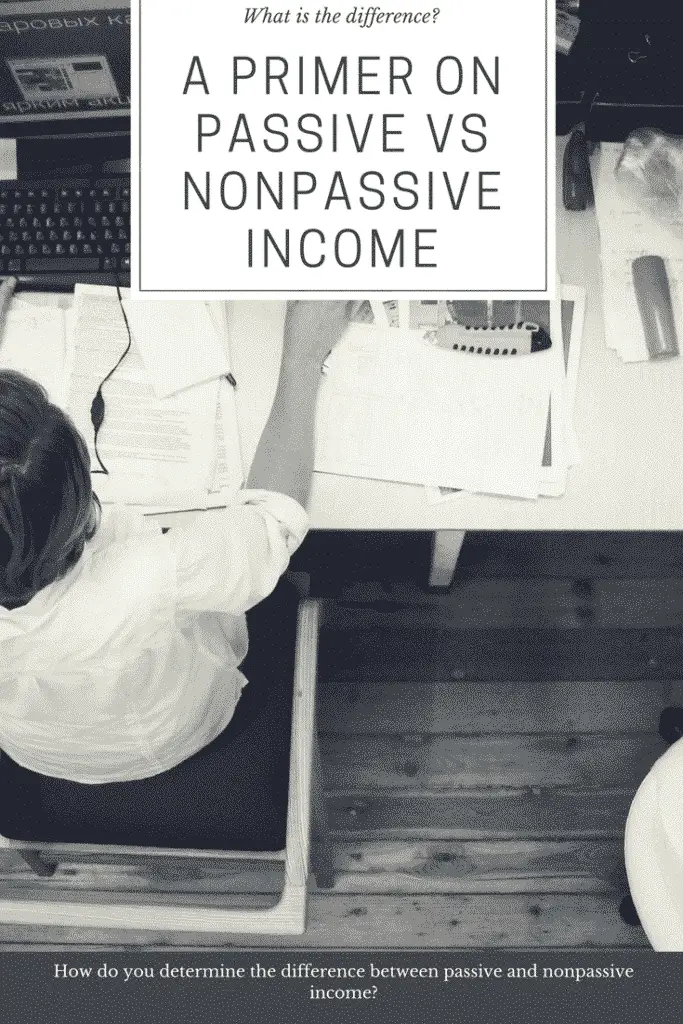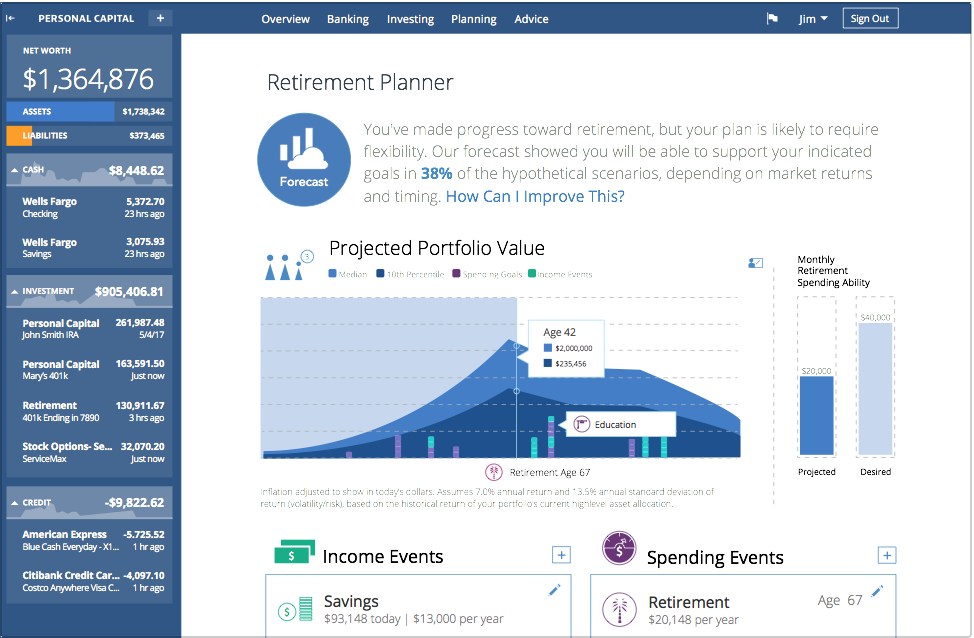Generally speaking, a number of people know work requirement differences between passive vs nonpassive income. However, how do you understand the tax implications of passive vs nonpassive income. Let’s review the difference between passive income and nonpassive income in detail.
A Primer on Passive vs Nonpassive Income
Income is essential to fund day-to-day expenditures. Passive and nonpassive incomes are the two most common types of revenues. The US revenue department has however subdivided income into three major categories essential for taxation purposes.
The different categories for income from a taxation perspective include:
- Passive income
- Nonpassive income
- Portfolio income
All of these different sources of income are important. Every person should have at least one from each of these categories as part of their daily income. This is the best way to ensure you are on a path to financial freedom. Having these different sources of active and passive income can get complicated from a tax perspective, so you must understand the different upfront.
So, what is the difference between passive and non passive income?
To be able to understand the difference, you first need to understand what constitutes passive income and nonpassive income. Different analysts define passive and nonpassive income differently.
Let’s explore what is passive and nonpassive income and what are the key factors that differentiate the two.

Here is the difference between passive and nonpassive income.
Passive Income Definition
Passive income is any revenue earned without doing any work or without engaging in any day to day activity. It is defined as regular income that you can receive from little or almost negligible efforts.
Passive income also constitutes earnings from work that you did once or something you once purchased. In which case, you are not actively involved in any management of the investment throughout the entire procedure of generating revenues.
There are numerous ideas for passive income which include investments in crowdfunded real estate, dividend income, Kindle Direct Publishing, among others. Passive income is also classified as earnings that are obtained from a rental property, limited partnership or any other enterprise where you generate earnings from something you are not actively involved in.
Hobby income can be either be classified as passive or nonpassive income depending on whether you actively get involved in the activity or not and for how long.
There are several examples of passive income that we can evaluate if they fall under passive or nonpassive income such as property income, royalty income and portfolio income.
Learn passive income from these amazing books.
Property Income
Property income is the amount of money that a landlord receives from the tenants for using his property or space. So, is rental income passive or nonpassive? Property income is one of the most popular forms of passive income.
When you build or purchase a residential or commercial property, any income that you get from tenants in terms of rental payments is deemed as passive income. You can also obtain property income from real estate investments such as Real Estate Investment Trust Funds (REITs).
However, there are instances when rental income won’t qualify as passive income and that is if you’re a real estate agent or professional who is actively involved in buying, selling and leasing of property.
In such a case, it is deemed to be nonpassive income. So, for one to understand whether any rental income is passive or nonpassive income, there is a need to evaluate if the investor is actively involved in any regular activity. Income rent is passive as long as you do not manage or maintain the property. Property is a great proven way to make money for doing little work.
Royalty Income
Royalty Income includes the earnings obtained for the use and exploitation of intangible works such as intellectual property, artistic or literary works or creativity, patents and mineral rights.
So, is royalty income passive or nonpassive income? Some analysts consider income that is obtained as royalties as passive income while others say it is nonpassive income. Royalty income is classified into two major types that include the use of copyrights, trademarks and patents and investing in the extraction of gas, oil and other minerals. Royalty income is taxable as ordinary income.
Investment is therefore deemed passive if the investor puts in an amount of money say $30,000 into a shop with a promise to get a percentage of earnings periodically as long as the investor does not participate in the business operation in any other way.
Some analysts classify interest income, dividends, royalties, gains and losses in stocks and any property held for investments as portfolio income. However, it all depends on the overall participation of the investor in these activities.
So what is portfolio income?
Portfolio income does not come from passive income and does not include income that you receive through regular business activity. It is income obtained from investments such as stocks, mutual funds, annuities and bonds among others. By monitoring your portfolio using Personal Capital, you can understand quickly what is portfolio income.
Personal Capital has a future value planning tools that tracks your current retirement savings. This is a free tool that enables you to build wealth effectively and monitor your accumulated wealth over time. It is very easy to link all of your accounts and is highly secure.
Here is what the Retirement Planner dashboard looks like:

Swell Investing is a great way to invest in high-growth companies that are solving global challenges. I love the ability to invest in impact at the retail level. One able to invest in these several categories:
- Renewable Energy
- Green Technology
- Disease Eradication
- Clean Water
- Zero Waste
- Healthy Living
Try investing with Swell to invest for change. Impact investing should be a part of everyone’s portfolio. Another example of passive income would include earning income from solar loans through Wunder Capital. These are other platforms that allow you to invest for impact passively.
Let’s now look at what is nonpassive income.
Nonpassive income definition
What is nonpassive income? Well, nonpassive income is revenue that cannot be classified as passive income and includes active income or earnings that you get for work done on a regular, substantial and continuous basis such as daily wages, monthly salary or the any other payment that you receive after you’ve performed tasks.
Think of nonpassive income as active income. Do you have an active role in generating this source of income? This will help you understand the difference between passive and nonpassive income. There are certain tax implications when considering active income, so let’s review the rules.
Tax deductions for passive vs nonpassive income
Passive and nonpassive income IRS (Internal Revenue Service) definition is based on how the income received is taxed. The taxpayer can be able to get all his tax details on the 26aS income tax form. IRS categorizes and treats each category differently and has set different tax deductions for each category. A tax of up to 35% may be applicable to nonpassive income whereas for passive income the percentage is lower and is around 10-20%.
Passive income technical definition of IRS includes either net rental income or income from a venture wherein the taxpayer doesn’t participate materially and to some extent includes self-charged interest.
The income earned can be classified as active if the investor did help in any way manage the company and has offered any form of “material participation”. The IRS has set up guidelines for “material participation” as:
- If you have set aside more than 500 hours for a business or any activity and you are earning profits then it’s a material participation.
- If the activity has been the “substantially all” of the participation for the given tax year, then it also falls under the material participation category.
- It is also considered material participation if the taxpayer has participated up to 100 hours and that is at least as much as any other person involved in that particular activity.
According to the IRS, when money is lent to a partnership or a corporation that acts as a pass-through entity by the entity’s owner, the income earned as interest on that loan to the portfolio income is classified as passive income. In this case, certain self-charged interest income or deductions may be deemed as passive activity gross income or deductions particularly if the loan proceeds are used in any passive way.
It is important to understand the three categories of income that is passive, nonpassive and portfolio income because losses in any category cannot be offset against another for instance losses in passive income cannot be offset against portfolio or the active income. It is therefore prudent for an investor to ensure that all the passive income activities are classified as that to be able to make the most of the tax deductions.
Difference between passive and nonpassive income
The difference between passive and nonpassive income, in essence, depends on the type of income in consideration. “Material participation” is an important aspect in determining whether the earnings received are passive or nonpassive. Material participation evaluates whether a taxpayer has materially participated in a trade, business, rental or other income-producing activity.
Keep that in mind come tax season to identify the difference between passive vs nonpassive income. There are certainly limitations when it comes to material participation. The participation of limited partners in enterprises owned by them is passive participation unless they pass material participation tests one, five or six.
However, when a taxpayer participates in two enterprises operated through the same pass-through entity, at least one of the seven tests for each venture must be met to be considered to have materially participated in both activities. I like to think of it as active vs passive income. Do you have active participation in the underlying income source?
Do you know the difference between passive and nonpassive income? Let us know what you think in the comments below. We’d love to hear from you.
With both a million credit card rewards points and a million dollar net worth you can live a happier lifestyle. Subscribe to our newsletter to find out the best travel tips, dividend growth stocks, passive income ideas and more.
Join our community of over 3,000 mobsters seeking financial freedom. What are you waiting for?







No Comment